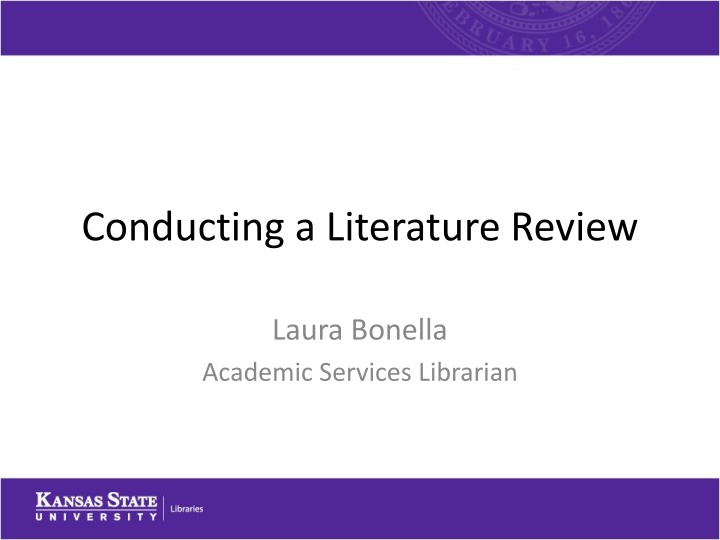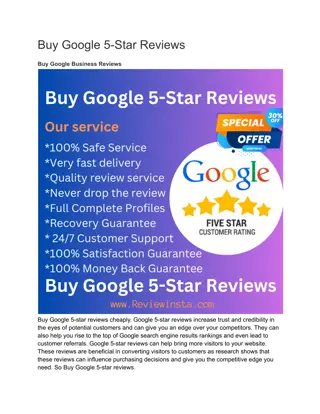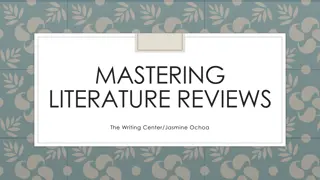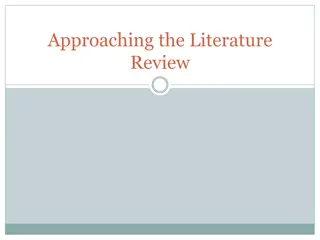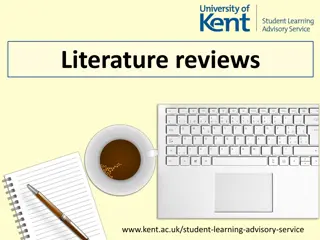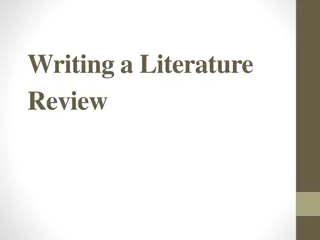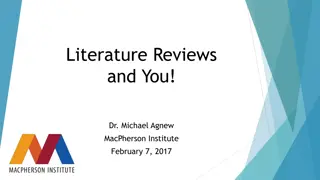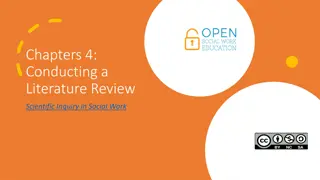Mastering the Art of Literature Reviews: A Comprehensive Guide
Learning how to conduct a literature review is essential for any academic researcher. This process involves summarizing, evaluating, and analyzing the existing research on a topic to identify gaps, relationships, and areas for further study. By mastering the techniques outlined in this guide, researchers can effectively establish the context, significance, and methodology of their study to make a valuable contribution to their field.
Download Presentation

Please find below an Image/Link to download the presentation.
The content on the website is provided AS IS for your information and personal use only. It may not be sold, licensed, or shared on other websites without obtaining consent from the author.If you encounter any issues during the download, it is possible that the publisher has removed the file from their server.
You are allowed to download the files provided on this website for personal or commercial use, subject to the condition that they are used lawfully. All files are the property of their respective owners.
The content on the website is provided AS IS for your information and personal use only. It may not be sold, licensed, or shared on other websites without obtaining consent from the author.
E N D
Presentation Transcript
Conducting a Literature Review Laura Bonella Academic Services Librarian
Librarians Will Help You! Find your librarian: Find your librarian Research guides: Guides BY SUBJECT Ask A Librarian: Research help
A literature review is a way to provide context for your paper a summary and evaluation of the significant research and/or theory published on a topic organized in a way that analyzes, integrates, and shows the relationship between research studies, as well as the way each has contributed to an understanding of the topic
The purpose of a literature review is to provide an overview of relevant literature, research, and methodology in an area of study by: exploring relationships among the prior research evaluating the prior research identifying gaps and discrepancies in the literature with the ultimate goal of: making an argument for why further study of your research question is important to the field
Benefits to the researcher (you!) include establishing the context and significance of the problem discovering appropriate subject vocabulary identifying methodologies identifying what has been researched and where gaps may be found underused methodologies, designs, populations focusing the research topic
Evaluation questions: What is the methodology ? What is the quality of the findings or conclusions? What are the article s major strengths and weaknesses ? What beliefs are expressed/is there an ideological stance? Can the results be generalized? How does it compare to other work in this field?
Searching for Articles Select appropriate database(s) Search strategies Cited reference searching
Writing the review The literature review should deal with relationships how do the articles relate to each other? How do the articles relate to your research?
In the literature review Explain the reason for reviewing the literature; explain why particular literature was included or excluded (particularly in articles that are solely literature reviews) Articles were included if the study design was a clinical trial, observational study, survey, or qualitative study; patient satisfaction with overall physical therapy care was evaluated as a main outcome; and participants were adults aged 18 years or older who had received a course of musculoskeletal physical therapy care in an outpatient or private clinic setting. Qualitative studies were included to provide an understanding of the dimensions of physical therapy care that contribute to patient satisfaction. Articles were excluded if: (1) the study had an inappropriate design (ie, not a clinical trial, observational study, survey, or qualitative study); (2) the study was related to delivery of services other than outpatient physical therapy care for musculoskeletal conditions; (3) patient satisfaction was not measured; (4) they described a clinical study in which participants were individuals recruited from the community rather than patients seeking physical therapy treatment; or (5) they primarily described clinimetric properties or the development of a patient satisfaction instrument. From: Hush, J. M., Cameron, K., & Mackey, M. (2011). Patient satisfaction with musculoskeletal physical therapy care: A systematic review. Physical Therapy, 91(1), 25-36.
In the literature review Summarize the major contributions of the significant articles Studies have considered a number of variables influencing the practice of breast-feeding, including perceived constraints (Li, Fridinger, & Grummer-Strawn, 2002), mother's age or race (Brownell, Hutton, Hartman, & Dabrow, 2002; Fooladi, 2001; Khoury, Mitra, Hinton, Carothers, & Sheil, 2002; Libbus & Kolostov, 1994; Wiemann, DuBois, & Berenson, 1998), the father's influence on infant feeding practices (Schmidt & Sigman -Grant, 2000; Sharma & Petosa, 1997), and other demographic factors such as geographic location, educational level, and occupation (Shelton & Wang, 1997). Bomba, Anne K,PhD., C.F.C.S., Chang, Y., PhD., Knight, Kathy B,PhD., R.D., Tidwell, Diane K, PhD,R.D., L.D., Wachter, K., PhD., Endo, S., PhD., & West, C. K., PhD. (2009). College students' attitudes regarding infant feeding practices. Journal of Family and Consumer Sciences, 101(1), 25-29.
In the literature review Evaluate and compare the articles Although Bernard's team unquestionably improved McVay's original survey by probing student self-efficacy with technology, the authors of this article posit that there is still room to query individuals more fully about their engagement with information and communications technology (ICT) including their attitudes about engaging with ICT. Dray, B. J., Lowenthal, P. R., Miszkiewicz, M. J., Ruiz-Primo, M., & Marczynski, K. (2011). Developing an instrument to assess student readiness for online learning: A validation study. Distance Education, 32(1), 29-47.
In the literature review Evaluate the current state of the research -- explain inconsistencies in theory or conclusions, gaps in research, trends in what has been published, and opportunities for further research The articles reviewed lacked specific workforce-related recommendations regarding CBPR. Few studies examined organizational factors influencing dissemination or implementation. -Harrop, J. P., Nelson, D. E., Kuratani, D. G., Mullen, P. D., & Paskett, E. D. (2012). Translating cancer prevention and control research into the community setting: Workforce implications. Journal of Cancer Education, 27, 157-64.
Ways to organize By theoretical approaches For many years, the attitude literature has been fragmented, both theoretically and empirically, so that analyses of attitude formation and change (e.g., via persuasion) were developed independently of models focusing on the impact of attitudes on behavior (Ajzen and Fishbein 2005; Fazio and Towles-Schwen 1999). Although two process models have dominated this discussion (see Bassili and Brown [2005]; Fabrigar, MacDonald, and Wegener [2005]; and Wyer and Albarrac n [2005] for related analyses), neither attempts to integrate attitude formation, retrieval, and reliance (in guiding behavior). One is based on attitude accessibility and its precursors (typically frequency and recency of exposure to the issue or object, such as through direct experience, and amount of processing of the information; see, e.g., Petty, Haugtvedt, and Smith 1995), and one is based on action context induced attitude construction. The latter is represented by two substantially different orientations: (1) a pure constructivist orientation in which evaluative judgments are assembled from cued cognitions and feelings; and (2) a program of research identifying conditions when attitudes are likely to be stable over time so that the same attitude that was formed and stored also guides behavior. -Cohen, J. B., & Reed, A. (2006). A multiple pathway anchoring and adjustment (MPAA) model of attitude generation and recruitment. Journal of Consumer Research, 33(1), 1-15.
Ways to organize By concept or issue The existing literature divides barriers to employment into two main categories, spatial (or contextual) barriers and individual barriers. -Haney, T. J. (2013), Off to market: Neighborhood and individual employment barriers for women in 21st century American cities. Journal of Urban Affairs, 35: 303 325
Ways to organize By methodologies employed The predominant use of quantitative research methods in prehospital studies is indicative of the need to provide objective data in a field constantly being tested the influence of prehospital care is often questioned and some authors call for the development of appropriate indicators for the accurate assessment of its effectiveness (MacFarlane, 2003; McLean, Maio, Spaite, & Garrison, 2002). The apparent bias for quantitative research in the prehospital field has been challenged through the increased acceptance of qualitative research methods in health sciences research (Molina Azor n & Cameron, 2010). There is certainly a growing recognition of the extended understanding available to researchers by combining qualitative and quantitative data sets in the same study in the emergency health field (Cooper, Porter, & Endacott, 2011). -McManamny, T., Sheen, J., Boyd, L., & Jennings, P. A. (2015). Mixed Methods and Its Application in Prehospital Research A Systematic Review. Journal of Mixed Methods Research, 9(3), 214-231.
Ways to organize By chronology, only if linear changes in thought have taken place Since the pioneering paper of Srednicki [1] there has been increasing interest in understanding and quantifying entanglement in quantum field theories Subsequently this area law was shown to be generic in space dimensions d 2 [2], ... However in 1993 Holzhey et al [3] showed that in a conformal field theory Subsequently this logarithmic behaviour was observed A more complete analysis of entanglement in 1 + 1-dimensional CFTs was given in [6] More recently [7] these methods -Cardy, J. (2013) Some results on the mutual information of disjoint regions in higher dimensions. Journal of Physics A: Mathematical and Theoretical. 46(28), 1- 16.
Tips You may use more than one organizational strategy Use subheadings to clarify the structure Use original sources -- do not cite works you have not read Minimize direct quotations by summarizing in your own words (with citations) Use appropriate quotation and citation methods to avoid plagiarism (See the Citations and Bibliographies research guide created by K-State Libraries http://guides.lib.k- state.edu/citations)
QUESTIONS? Recordings will be posted here: https://lib.k-state.edu/services-support/teaching-resources/graduate- student-workshops/
